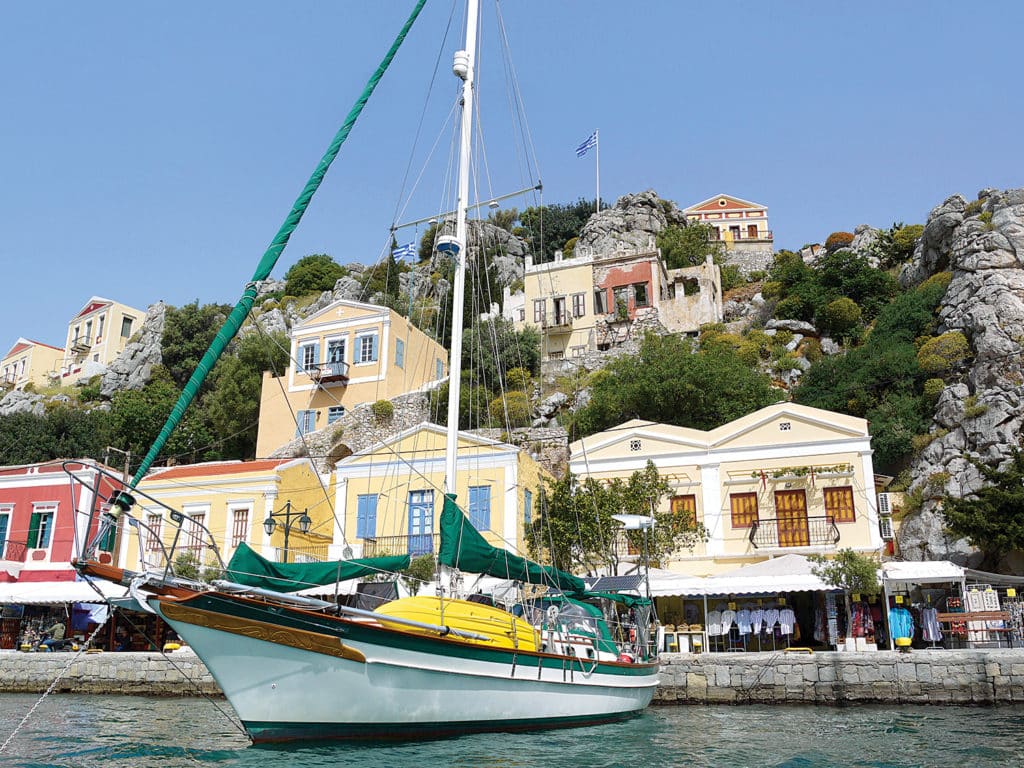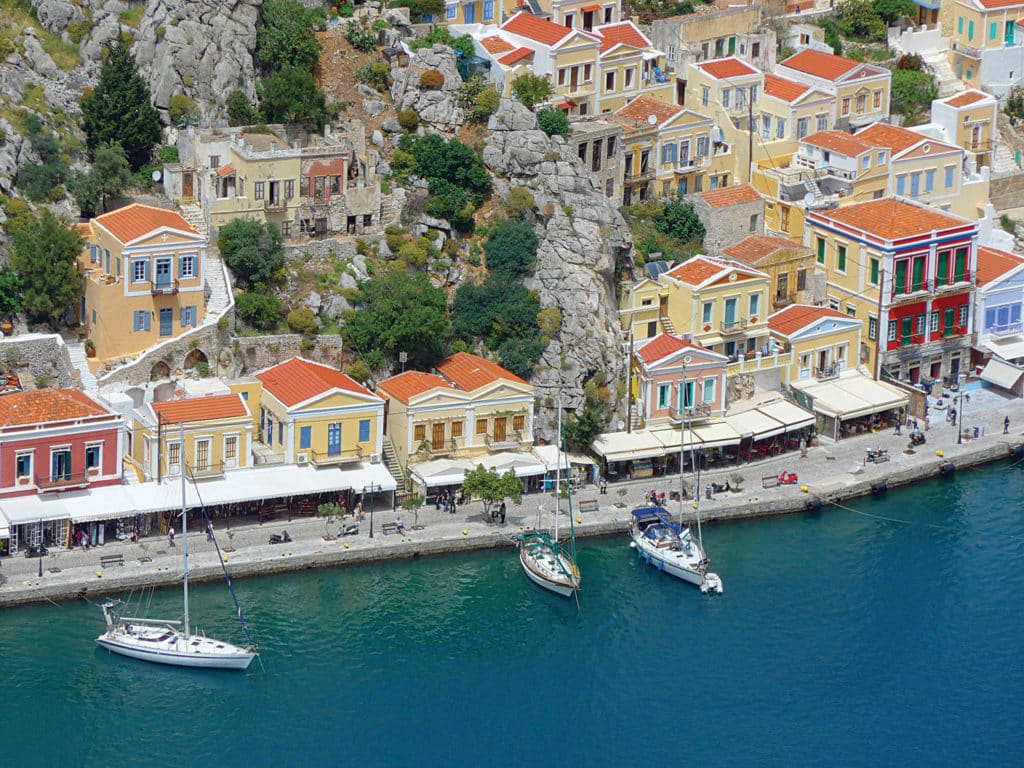
We’re anchored in the Greek island of Symi, stern tied to a stone quay in the picturesque pastel-colored village of Yialos—a town so absolutely idyllic and harmoniously composed, you would think it the work of Athena.
It is a Med-mooring experience at its finest, one where you step from the transom of your boat right into a Mediterranean postcard: a local cafe or taverna just a few feet from your cockpit, where chairs and round tables draped in checkered cloth rest on cobbled streets warmed by the sun, and depending on the time of day or your mood, you can order a cup of coffee accompanied by a warm loaf of sweet tsoureki, or a glass of chilled local retsina wine.
Med mooring is a technique of berthing in the Mediterranean Sea that, due to the vast number of boats cruising the region and the absence of any discernible tidal range, allows vessels to anchor and tie stern-to a dock or quay, typically in the center of town.
This was our first stern-to mooring in a Mediterranean town, and it quickly became an unforgettable experience. By sheer proximity you feel a connection to the community, and after just a few days, when locals recognize you as being more permanent than the day tourists arriving by ferry from Rhodes, they begin to include you in their day, sharing smiles, pleasantries, local walks and island secrets. One merchant offered his car should we feel the urge to explore the island, and a store owner included a free bottle of local red wine with our groceries. Right away, we felt at home here.
It was early in the cruising season, so there were only three other yachts berthed alongside Dream Time, our 1981 Cabo Rico 38, but during peak summer months, dozens squeeze together on the quay, filling it past capacity and jostling for room with barely fender space to spare. But for now, at least, the cafes and quay are unhurried, and while sailors relaxed in their cockpits, locals and tourists smiled down as they passed, some stopping to ask questions about the boats or the voyages. For me, the relaxed intimacy of feeling connected to a small seaside community is one of the great pleasures of a Mediterranean mooring. But it can come at a price.
“Opa!” is a Greek exclamation traditionally reserved for smashing plates or shouting loudly after stubbing your toe on a deck cleat. But over the years, its meaning has evolved to also express joy and celebration. But because Med mooring can be a tricky business, more often than not, especially when berthing in Symi, the traditional cry of “opa!” can regularly be heard echoing across the amphitheatrical bay as new arrivals or departures struggle with their ground tackle.
Symi Harbor is 40 to 60 feet deep with a rocky mud bottom that a local pilot book describes as poor holding. The narrow harbor requires anchors not only to be carefully placed to avoid crossing the chains of your immediate neighbors, but also aligned to avoid snagging the anchors and chains of boats berthed on the opposite quay.
Dropping the anchor in the right location is a mild challenge, but backing your boat toward a crowded quay while paying out chain and negotiating your stern into a space barely the width of your beam can seem almost impossible, especially if you’ve had little practice with the maneuver or there’s a brisk crosswind and your boat is like Dream Time—a full keel, no bow thruster and stubborn as a Santorini mule when going astern. Let’s just say that the potential for an enthusiastic “opa!” runs high.

Local officials seem happy to add to the chaos, blowing whistles to get your attention before loudly shouting orders (in Greek) at arriving captains, and heckling those they deem incompetent or take a dislike to. And if that’s not enough to make you clench your jaw, all this typically happens under the amused gaze of hundreds of spectators sipping a drink while lounging in the cafes and tavernas that line the quay within perfect viewing distance.
With great relief, Dream Time’s arrival was one that found an almost empty quay and just a light breeze. We dropped the anchor in 45 feet, and with a scope of 4-to-1 had both stern lines passed to a local official and secured to bollards in just a few minutes, and received only one blast from the whistle. Other captains were not so lucky—one foreign yacht flying a rather weathered Greek courtesy flag was spectacularly reprimanded and ordered to immediately purchase a new one from the local chandlery. Another yacht lost its mooring pole when attempting to untangle a snagged chain, and after finally freeing itself, miraculously managed to snag another. And all this excitement occurred in just a single afternoon.
Dream Time, unfortunately, did not manage to escape an “opa!” moment. Frustratingly, when our neighbor departed, due to the poor placement of their ground tackle the night before, they dragged us down the dock before relocating our anchor just off our bow, shortening our scope and requiring us to completely reset our berth. But weather conditions were favorable, it was all good practice and, we later learned, a routine exercise of the colorful Med-mooring experience.
RELATED: On the Hook in Delos, Greece
Most captains here seem skilled in the art of unfouling ground tackle using a simple technique that involves raising their anchor, looping a line under the snagged chain to take the load, then releasing the rope, allowing their neighbor’s chain to fall back to the seabed. Considerate assailants will attempt to drop a lifted hook back to where they found it; if not, the victim will have to reset their anchor and scope, much to the amusement of those ashore cheering from the comfort of a lounge chair.
Our second “opa!”—and one experienced by all the yachts berthed in Symi that morning—occurred at 0700, when an early car ferry entered the harbor along with an impressive wake that cascaded around the stone walls, causing all the boats to stretch their lines and surge forward and aft over 6 feet. Boats with shorter stern lines and passerelles, and perhaps berthed a little too close, collided with the quay, where stone crunched without mercy against swim platforms and fiberglass transoms before captains and crew—most fresh from their bunks and wearing very little—emerged to start engines and engage transmissions.
Dream Time survived unscathed thanks to a giant fender ball we’ve been carrying around the world for 12 years and, until Symi, had used only once, while transiting the Panama Canal. Our outboard engine, however, which was clamped to the stern rail, clipped the wall, resulting in a mildly bent propeller. But this, we think, is a small price to pay to be stern-tied to one of the prettiest towns in all of Greece.
Neville Hockley and his wife, Catherine, have recently crossed the Atlantic and are spending the winter in the Caribbean before closing the loop on their circumnavigation. To read more about their voyage, visit zeroXTE.com.








